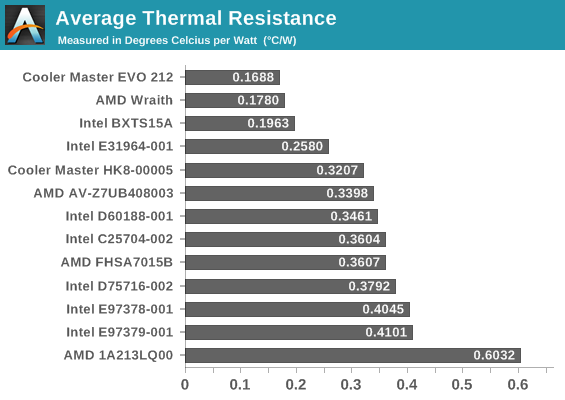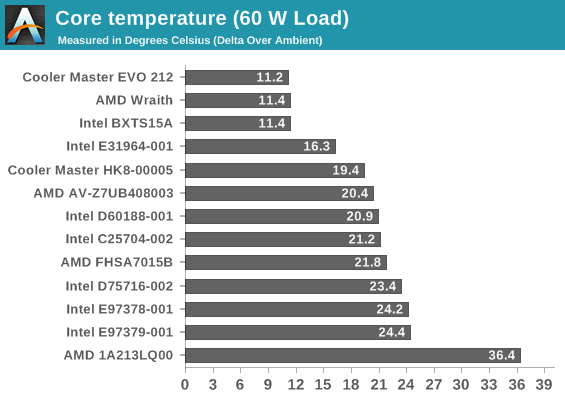Battle of The CPU Stock Coolers! 7x Intel vs 5x AMD, plus an EVO 212
by E. Fylladitakis on July 22, 2016 9:00 AM EST- Posted in
- Cases/Cooling/PSUs
- CPUs
- AMD
- Intel
- Cooler Master
- Cooler
Testing Results, Maximum Fan Speed (12 Volts)
Most of the stock coolers were tested with a maximum load of 150W, lest we start a fire. These products were not meant to handle thermal loads way higher than the stock specifications of the CPUs they were being shipped with.

Looking immediately at the average thermal resistance and we see three main coolers out in front, and it is no surprise that these three are the beefiest - the EVO 212, the Wraith and the BXTS15A. The small Kabini cooler is designed for very low power, and our small test here pushes it outside of its window.

| Core Temperature, Constant Thermal Load (Max Fan Speed) |
As we move up the thermal loads, from 60W all the way up, the coolers by and large stay in their positions, with small differences becoming more pronounced as the load increases.

The EVO's large 120mm fan keeps the RPM down here, and it is interesting to see the RPM and noise of the BXTS15-A go far and above the other coolers.

An interesting observation would be that Intel’s coolers meant for a specific socket have about the same absolute thermal resistance regardless of the core’s material. Taking socket 775 coolers as an example, the aluminum D75716-002 performs similarly with the copper C25704-002, most likely due to its solid core, and the tall copper D60188-001 also performs similarly due to the much slower (and quieter) fan. The same goes for the aluminum E97379-001 and the copper E97378-001 socket 1155 coolers, the former of which simply has a significantly more powerful fan attached. The E31964-001 performs significantly better but its high performance is not just due to its size and copper fins, as the fan is quite fast and loud as well.
In AMD’s camp, the simple and cheap FHSA7015B displays reasonable thermal performance at the expense of comfort, as the maximum speed of its fan is quite high. The more advanced AV-Z7UB408003 offers only slightly better thermal performance but noise levels were significantly lower. The Cooler Master HK8-00005 beats both of the aforementioned coolers in terms of thermal performance but its noise levels are rather high. This was to be expected, as it is based on the core design of the AV-Z7UB408003 but is significantly smaller, therefore a more powerful fan would have to make up for the loss of mass. Finally, the small 1A213LQ00 realistically has by far the worst overall performance of every cooler we tested here today, as the little cooler is designed with AMD’s power efficient AM1 CPUs in mind and cannot be directly compared to any of the other coolers in this review.
Both of AMD’s Wraith and Intel’s aftermarket BXTS15A stand out, pulling ahead in terms of performance the rest of the stock coolers. AMD’s Wraith is but a breath away from Cooler Master’s EVO 212 and the BXTS15A does not fall far behind. There is a catch though and that is the fans. Both the Wraith and the BXTS15A are making use of very strong fans, with a much higher top speed than that of the 120 mm fan that the EVO 212 is using. Strong fans are not just inherently louder themselves but the high air turbulence they create effectively multiplies the sound pressure level of the setup.










82 Comments
View All Comments
ZeDestructor - Monday, July 25, 2016 - link
Yes they could, but then you'd be reducing yields, which would drive final price up.pseudoid - Friday, July 22, 2016 - link
Did I miss the part about the SkyLake (LGA 1151) uPs? The Intel boxed Core I7-6700K Skylake uP comes with no cooling fan. I found that the Noctua coolers are a better fit for my needs, especially the iron-clad 3yr. warranty!LordanSS - Friday, July 22, 2016 - link
Thank you for this review.Although I already expected the 212 EVO to pull ahead (it's tough to match it on price/performance), was interesting to see the differences on the other stock ones. And the Wraith came out as a pleasant surprise.
Maybe in the US it's all about Intel and their CPUs, but in other areas of the world, like here in South America, AMD and their APUs are not doing poorly, with very good (local) pricing and decent enough performance for usual Office and light work cases, and people even use them for League of Legends and DotA2, which are very popular games around here, and not too graphics intensive.
zodiacfml - Friday, July 22, 2016 - link
I went to Intel's list of Skylake desktop CPU's and found only two that has around 90W of TDP.The 212 is only 25C above ambient at 150W.
Anything larger or more expensive than the 212 is pretty much overkill for modern CPUs.
wintermute000 - Friday, July 22, 2016 - link
"modern [Intel standard desktop] CPUs"FIFY
Ascaris - Sunday, July 24, 2016 - link
"modern [Intel standard desktop] CPUs at their stock clock and voltage settings"Byte - Saturday, July 23, 2016 - link
The hyper 212 is a bit overrated and dated, but then again i used it to test a bunch of 6700k i had fun delidding with liquid ultra and it kept them cool to 4.6/4.7GHz pretty easy.phylop - Saturday, July 23, 2016 - link
I would love to see you guys post an anthology of coolers throughout the ages. Include comparing how older coolers would perform on modern CPUs and vice versa.Teknobug - Saturday, July 23, 2016 - link
The 212 is probably the best bang per buck for HSF, can't go wrong with it. I also have a TX3 which is nearly as effective as the 212 and about $10 less, however there is one thing you must do if you're going to use it on an Intel system- ditch the flimsy black/white plastic locks and steal the ones from an Intel HSF to replace them with. Once you do that, you got a pretty solid HSF even for decently OC'd CPU's.Zap - Saturday, July 23, 2016 - link
IMO stock coolers are perfectly fine for systems that run stock speeds and aren't intended to sit running torture tests all day.Noisy? Did you enable "smart fan" in BIOS? Is that in normal use or hammering it with Prime95?
Bad temperatures? Did you install it properly? For whatever reason many people can't figure out push pins when they are super simple to use. Is your temperature "comfort level" calibrated for overclocks when you're just building a stock clocked system for family to use? Fact: Your stock clocked CPU does not require low temperatures.